FOR THE FIRST TIME – THE FULL FACTUAL STORY OF AL BOWLLY AND HIS LIFE OF MUSIC AND SONG.
WRITTEN AND RESEARCHED BY RAY PALLETT (1975)
In the States, Al had reached a new high spot in his career. However, realising that the sophisticated New York life was not for him, and feeling overall that he could do even better in England, he decided to return home to London. So at the end of 1936, Al quit the Ray Noble Orchestra,and with Al’s departure the band lost much of its identity and shortly broke up. Ray Noble recognised Al’s vocal talent back in 1930 before he had his big break and it was through Ray that Al made so many excellent records and was invited to America. With Al and Ray breaking up, what was surely one of the greatest dance music partnerships, ended. Their last record together was made in October 1936 and entitled “Where the lazy river goes by”, and “There’s something in the air”.
It was not until he announced his departure from New York that he realised how many friends he had made in the New York music world. Some of them got together and presented Al with a parting gift — a large leather suitcase with a silver plaque inscribed :— “To Al Bowlly from Ave Lyman and all the music men of New York City.” This indeed was a very appropriate tribute and gesture for Britain’s favourite popular singer who had also won the hearts of the American public and music world.
However, Al’s visit to America was a chapter in his life he did not speak very much of because from a domestic angle America had unhappy memories. For his second marriage to the beautiful Marjorie broke up. It was not long after they were married when they separated. Although America was not the happiest time for Al personally, professionally it was the high spot of his career. Ray Noble later recalled that when Al was on tour through the States he left a trail of broken female hearts behind him and he was meeting Crosby and the rest of them on their home ground and beating them at their own game.
Back in Britain, Al was home in time for the 1936-37 New Year’s celebrations in London in which he took part. The news soon got around that he was back and he resumed his variety work and guested with one or two dance bands. But this was not a happy time for Al for he was often confronted by an air of hostility among some of his “friends” who may have been envious of his success in America. As well as these problems, his throat started troubling him slightly, but he still pressed on with his work. During his stay in America, Al went out of the public eye somewhat in this country as his voice was seldom heard on the radio. Sam Browne had become Britain’s favourite singer. Later in 1937, in the Melody Maker poll, Sam was still top vocalist with Al Bowlly No. 2.
Al Bowlly’s ambition at the beginning of 1937 was to get his own show on the road, and so with his younger brother, Mish, who came over from South Africa, Al formed his own band called “Al Bowlly’s Radio City Rhythm Makers”. The band made its debut on March 1st 1937 at the Birmingham Empire, where they scored a resounding success. They toured for several weeks, playing in such well known places as the Hammersmith Palais de Danse.
They crossed the Irish sea to play in Dublin , but on the very first night there his throat started troubling him and on the next day he actually lost his voice. So for the rest of the week he had to apologise on the stage for being unable to do anything other than conduct the band. The following week showed a gap in the engagement diary and the weeks ahead showed better prospects of any work. So the inevitable happened and the band broke up. Dissatisfaction had been felt among the musicians who were generally relegated to fairly minor parts in the act. To quote the “Melody Maker”, the moral was that even such a popular artiste as Al Bowlly could not run a stage band as a mere accompaniment unit in those days when jazz bands were expected to be a complete variety show in themselves. The sad story of Al Bowlly’s Radio City Rhythm Makers is unfortunately summed up as seven weeks rehearsal for four weeks work. Moreover, the venture resulted in a heavy financial loss for Al.
The Rhythm Makers never recorded and since his return from America Al did not make records until June 1937, by which time his voice had returned to him. This was the longest in his recording career since his arrival in England in 1928. In July 1937, shortly after a session with Ronnie Munro and his Orchestra, Al lost his voice once again. On the Munro disc sounds as if he had a cold — but it was much more serious than this. His surgeon diagnosed a wart on his vocal chords and there was no surgeon in England capable of performing the operation was necessary. The only surgeon that could perform this delicate operation was in America, and he could only offer a 50 – 50 chance of success. Notwithstanding this, Al decided to have the operation,and the trip to America, together with the medical fees meant that he had to find a large sum of money. This was not easy so soon after his heavy deficit over the Rhythm Makers Band and subsequently being made redundant due to loss of voice.
Al had now reached what was probably the lowest ebb in his life. Al was the sort of person who could be elated one day and in the depths of depression the next. He was now the most depressed that he had ever been, and absolutely frantic with worry over the diagnosis, for his voice meant everything, to him. This had a very bad effect on his health and he lost over thirty pounds in weight. He later stated in an interview:— “The day came when I woke up and found my voice had gone. I stayed in bed. I cried and went on crying. I tried to force my voice — tried to force out some sound, to swear at myself, to give vent somehow. I reckon I knew how a women would feel when she sees her child dying away. The voice was gone — oh, but / can’t begin to tell you how I felt There aren’t enough words.”
Al now had to find the money for the trip back to America and for the operation. There was some money owing to him from some “devoted friends” but when he went round to see them they just said ‘tomorrow’ or ‘the next day’. He could not raise a penny. These “friends” started rumours that his voice was failing through drink. Just one friend and his brother Mish came to the rescue, and kept his spirits up, and together raised the money that was so desperately needed. In the autumn of 1937 Al returned to the U.S.A. for the operation. Since his voice had gone, Al had to turn down some very good offers that he received for engagements. Just before he was to have his operation he was offered a very lucrative job to star in a stage show in Rio de Janeiro, Brazil. Al could have brought with him any acts he liked to fill half of the show. Nevertheless, with his voice in jeopardy, he had to turn down the job.
















